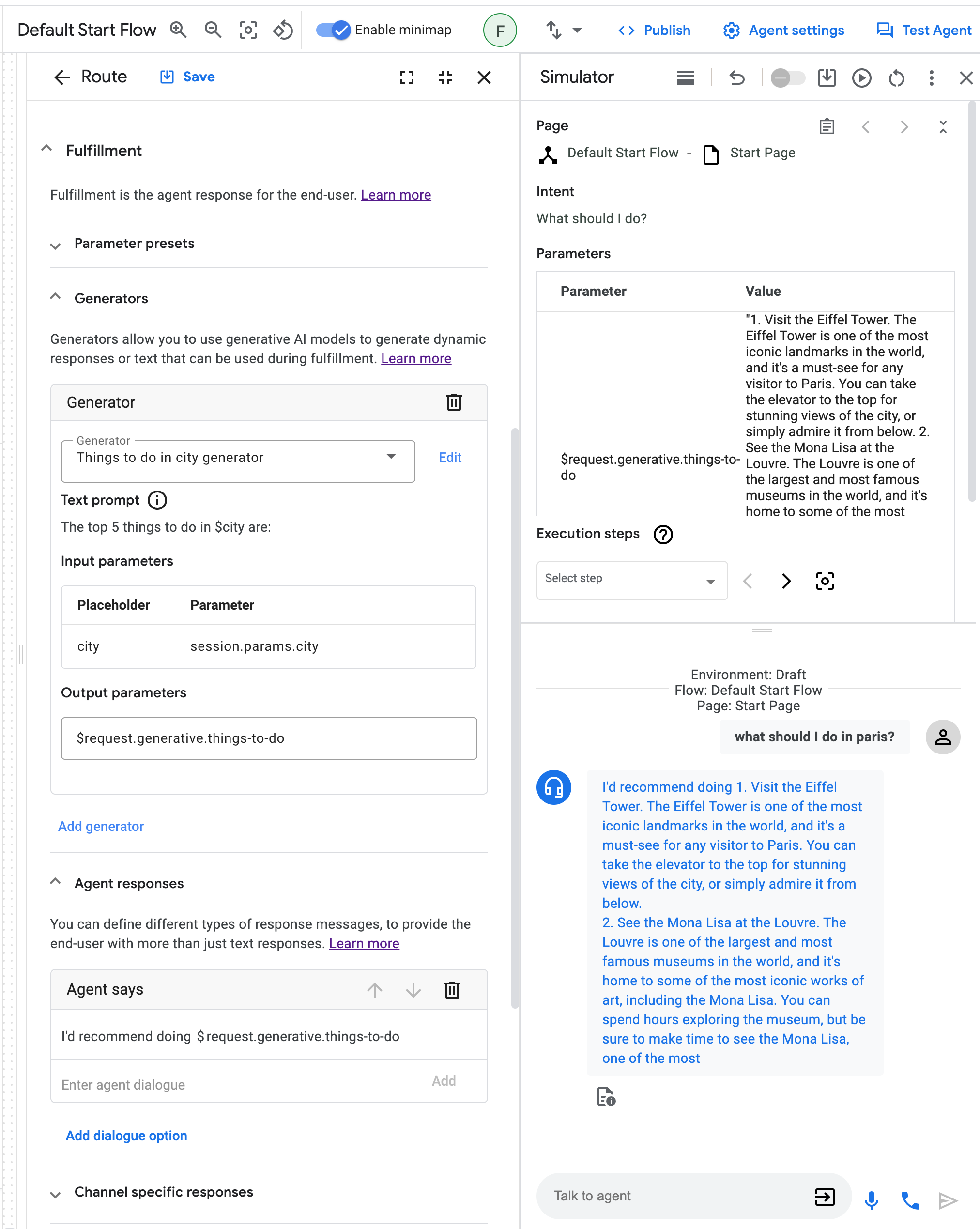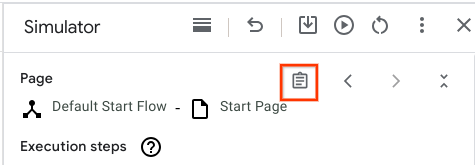生成ツールは、Google の最新の生成大規模言語モデル(LLM)とユーザーが提供するプロンプトを使用して、実行時にエージェントの動作を生成します。 使用可能なモデルは、Vertex AIから提供されます。
生成ツールを使用すると、独自の外部 Webhook を作成しなくても、会話エージェント(Dialogflow CX)からネイティブで LLM を呼び出すことができます。通常は LLM に要求するすべての処理を行うように生成ツールを構成できます。
生成ツールは、要約、パラメータ抽出、データ変換などのタスクに適しています。詳細については、以下の例をご覧ください。
制限事項
この機能は、どの Dialogflow 言語のエージェントでも利用できます。ただし、使用可能なモデルの言語制限が厳しくなる場合もあります。詳細については、Vertex AI をご覧ください。
生成ツールのコンセプトを理解する
Vertex AI のドキュメントには、Dialogflow の生成ツールの作成時に理解すべき重要な情報が記載されています。
生成ツールを定義する
生成ツールを作成するには、次の手順を実施します。
- Dialogflow CX コンソールに移動する。
- Google Cloud プロジェクトを選択します。
- エージェントを選択します。
- [管理] タブをクリックします。
- [生成ツール] をクリックします。
- [新規作成] をクリックします。
- 生成ツール用に、わかりやすい表示名を入力します。
- コンセプトにテキスト プロンプト、モデル、コントロールを入力します。
- [保存] をクリックします。
テキスト プロンプトは、実行時の入力中に生成モデルに送信されます。モデルが満足のいくレスポンスを生成するためには、質問または要求は明確である必要があります。
単語の前に $ を追加すると、単語をプレースホルダとしてマークすることで、プロンプトをコンテキストにできます。これらの生成ツール プロンプト プレースホルダを入力のセッション パラメータに関連付けると、実行時にセッション パラメータ値に置き換えられます。

セッション パラメータに関連付ける必要のない、特別な生成ツール プロンプト プレースホルダがあります。これらの組み込み生成ツール プロンプト プレースホルダは次のとおりです。
| 用語 | 定義 |
|---|---|
$conversation |
ユーザーの最後の発話と、それ以降のエージェントの発話を除く、エージェントとユーザー間の会話。 |
$last-user-utterance |
ユーザーの最後の発話。 |
入力での生成ツールの使用
生成ツールは、入力中(ルート、イベント ハンドラ、パラメータなど)で使用できます。
[入力] ペインの [生成ツール] セクションに移動し、展開します。 [生成ツールの追加] をクリックします。事前定義された生成ツールを選択するか、適切な新しい生成ツールを定義できます。
生成ツールを選択したら、プロンプトの生成ツール プロンプト プレースホルダをセッション パラメータに関連付ける必要があります。これを行うには、実行後に生成ツールの結果を含む出力パラメータを定義する必要があります。[出力パラメータ] フィールドに、出力パラメータの名前を入力します(例: things-to-do)。この出力パラメータは、後で参照できるセッション パラメータに書き込まれます。
出力パラメータを使用して、後で生成結果を参照できます(エージェント レスポンス: I'd recommend doing $session.params.things-to-do など)。
パラメータの形式と使用方法の詳細については、パラメータのドキュメントをご覧ください。
生成ツールをテストする
生成ツール 機能は、シミュレータで直接テストできます。

例
このセクションでは、生成ツールのユースケースの例を示します。 生成ツールは大規模言語モデル(LLM)に基づく生成テクノロジーであり、次の例に示すプロンプトを使用した場合のそれぞれの結果は、ここに記載した出力と異なることがあります。Google から返されるプロンプトの結果はすべてベスト エフォートです。
コンテンツの要約
この例では、コンテンツを要約する方法を示します。
質問:
Your goal is to summarize a given text.
Text:
$text
A concise summary of the text in 1 or 2 sentences is:
会話の要約
この例では、会話の要約を提供する方法を示します。
質問:
You are an expert at summarizing conversations between a User and an Agent.
When providing the summary, always start with "Dear $email_address, the conversation summary is as follows:"
Provide a summary in a few bullet points.
Try to be as brief as possible with each bullet point,
only noting the key points of the conversation.
Output the summary in markdown format.
Conversation:
$conversation
Summary:
解決済みプロンプト:
会話の例では、生成モデルに送信される解決済みプロンプトは次のようになります。
You are an expert at summarizing conversations between a User and an Agent.
When providing the summary, always start with "Dear joe@example.com conversation summary is as follows:"
Provide a summary in a few bullet points.
Try to be as brief as possible with each bullet point,
only noting the key points of the conversation.
Output the summary in markdown format.
Conversation:
Agent: Good day! What can I do for you today?
User: Hi, which models can I use in Conversational Agents (Dialogflow CX)'s generators?
Agent: You can use all models that Vertex AI provides!
User: Thanks, thats amazing!
Summary:
マークダウンの書式設定
この例は、Markdown でテキストをフォーマットする方法を示しています。
# Instructions
You are presented with a text and your goal is to apply markdown formatting to text.
**NOTE:** Do not change the meaning of the text, only the formatting.
# Example
## Text
Generators allow you to use Googles latest generative models to format text,
or to create a summaries, or even to write code. What an amazing feature.
## Text in Markdown
*Generators* allow you to use Google's latest generative models to
* format text
* create a summaries
* write code
What an amazing feature.
# Your current task
## Text
$text
## Text in Markdown
質問への回答
この一連の例では、生成ツールを使用して質問に回答する方法を示しています。
まず、生成モデルの内部知識に頼って質問に答えることができます。ただし、モデルはトレーニング データに含まれている情報に基づいて回答を提供します。回答が正しいか、最新の情報であるかは保証されません。
自己の知識を使って質問の回答を促す
Your goal is to politely reply to a human with an answer to their question.
The human asked:
$last-user-utterance
You answer:
提供された情報を使って質問の回答を促す
ただし、提供した情報に基づいてモデルで回答を得る場合は、プロンプトに情報を追加できます。提供したい情報が多すぎない場合(レストランの小さなメニューや会社の連絡先情報など)に適しています。
# Instructions
Your goal is to politely answer questions about the restaurant menu.
If you cannot answer the question because it's not related to the restaurant
menu or because relevant information is missing from the menu, you politely
decline to answer.
# Restaurant menu:
## Starters
Salat 5$
## Main dishes
Pizza 10$
## Desserts
Ice cream 2$
# Examples
Question: How much is the pizza?
Answer: The pizza is 10$.
Question: I want to order the ice cream.
Answer: We do have ice cream! However, I can only answer questions about the menu.
Question: Do you have spaghetti?
Answer: I'm sorry, we do not have spaghetti on the menu.
# Your current task
Question: $last-user-utterance
Answer:
動的な情報を使って質問の回答を促す
多くの場合、モデルで回答の根拠となる情報は、プロンプトに貼り付けるには多すぎます。この場合、生成ツールをデータベースや検索エンジンなどの情報検索システムに接続して、クエリに基づいて情報を動的に取得することができます。単にそのシステムの出力をパラメータに保存し、プロンプト内のプレースホルダに接続するだけで済みます。
# Instructions
Your goal is to politely answer questions based on the provided information.
If you can't answer the question given the provided information, you politely
decline to answer.
# Provided information:
$information
Question: $last-user-utterance
Answer:
コード生成
この例では、生成ツールを使用してコードを記述する方法を示しています。ここでは、コード生成用に特別にトレーニングされた生成モデルを使用することをおすすめします。
プロンプト
# Instructions:
Your goal is to write code in a given programming language solving a given problem.
Problem to solve:
$problem
Programming language:
$programming-language
# Solution:
人間のエージェントへのエスカレーション
この例は、人間のエージェントへのエスカレーションを処理する方法を示しています。プロンプトの最後の 2 つの手順は、モデルが冗長になるのを防ぎます。
質問:
# Instructions:
You are a polite customer service agent that handles requests
from users to speak with an operator.
Based on the $last-user-utterance,
respond to the user appropriately about their request to speak with an operator.
Always be polite and assure the user that you
will do your best to help their situation.
Do not ask the user any questions.
Do not ask the user if there is anything you can do to help them.
# Answer:
検索語句の生成
この例は、ユーザーが指定した Google 検索クエリを最適化する方法を示しています。
質問:
# Instructions:
You are an expert at Google Search and using "Google Fu"
to build concise search terms that provide the highest quality results.
A user will provide an example query,
and you will attempt to optimize this to be the best Google Search query possible.
# Example:
User: when was covid-19 first started and where did it originated from?
Agent: covid-19 start origin
# Your task:
User: $text
Agent:
顧客情報の取得
この例では、文字列または JSON 形式で指定された情報の取得と検索を行う方法を示します。これらの形式は、Dialogflow セッション パラメータでよく使用されます。
質問:
You are a database engineer and specialize in extracting information
from both structured and unstructured data formats like CSV, SQL, JSON,
and also plain text.
Given a $user_db, extract the information requested
by the user from the $last-user-utterance
EXAMPLE:
user_db: {'customer_name': 'Patrick', 'balance': '100'}
User: What is my current account balance?
Agent: Your current balance is 100.
Begin!
user_db: $user_db
User: $last-user-utterance
Agent:
JSON オブジェクトの更新
この例は、ユーザー(または Webhook)から入力 JSON オブジェクトを受け取り、ユーザーのリクエストに基づいてオブジェクトを操作する方法を示しています。
質問:
You are an expert Software Engineer
that specializes in the JSON object data structure.
Given some user $update_request and existing $json_object,
you will modify the $json_object based on the user's $update_request.
EXAMPLE:
json_object = { "a": 1, "b": 123 }
User: Add a new key/value pair to my JSON
Agent: What do you want to add?
User: c: cat
Agent: { "a": 1, "b": 123, "c": "cat"}
json_object = {"accounts": [{"username": "user1", "account_number": 12345}, {"username": "user2", "account_number": 98765}], "timestamp": "2023-05-25", "version":"1.0"}
User: Add a new value for user1
Agent: What do you want to add?
User: birthday, 12/05/1982
Agent: {"accounts": [{"username": "user1", "account_number": 12345, "birthday": "12/05/1982"}, {"username": "user2", "account_number": 98765}], "timestamp": "2023-05-25", "version":"1.0"}
json_object = $json_object
User: Add a new key value to my db
Agent: What do you want to add?
User: $last-user-utterance
Agent:
Codelab
生成ツールの Codelab もご覧ください。
トラブルシューティング
機能をデバッグする場合は、Dialogflow コンソールのシミュレータで、解決された大規模言語モデル(LLM)の入力プロンプトを調べることができます。
[元のレスポンス] ボタンをクリックします。

[生成ツール LLM 入力] フィールドを見つけます。これらのフィールドを書式なしテキストとして読み込み、LLM 入力が理にかなっているかを確認します。フレーズに
$が含まれる場合、シミュレータの入力を調べて、プロンプト内の$が意図的なものかどうかを明確にします(例:price is $10の$が意図的であると考えられるものの、visit $cityは意図的ではなく、誤用またはバグを示していると考えられる場合)。[生成ツール LLM 入力] オプションがフィールドが見つからない場合、サポートにお問い合わせください。

